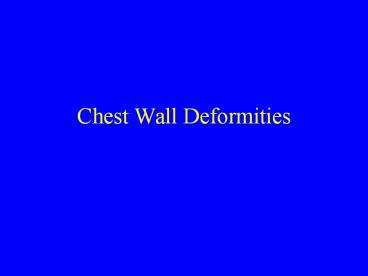Chest Wall Deformities - PowerPoint PPT Presentation
1 / 25
Title:
Chest Wall Deformities
Description:
Pectus excavatum is posterior depression of the sternum and costal cartilage due ... 2. Ectopia cordis. Thoracic Deformities in Diffuse Skeletal Disorders ... – PowerPoint PPT presentation
Number of Views:2649
Avg rating:3.0/5.0
Title: Chest Wall Deformities
1
Chest Wall Deformities
2
Categories of Congenital Anterior Chest Wall
Deformities
- 1. Pectus excavatum
- 2. Pectus carinatum
- 3. Polands syndrome
- 4. Sternal defects
- 5. Miscellaneous
3
Congenital Heart Disease Associated with Pectus
Excavatum and Pectus Carinatum
- Aortic ring
- AR
- ASD
- VSD
- TOF
- PDA
- TGA
- Ebsteins malformation
- TAPVR
4
Pectus Excavatum( Funnel Chest )
- Pectus excavatum is posterior depression of the
sternum and costal cartilage due to over grow of
costal cartilage. - The 1st and 2nd ribs, manubrium are in normal
position. - Asymmetrical of the depression may be present and
the right is often more depressed than the left.
5
Pectus Excavatum
- Pectus excavatum is present at birth or within
the 1st year of life in most patients. - It may worsen at adolescent.
- It may be associated with scoliosis, asthma.
6
Etiology and Incidence of Pectus Excavatum
- It is reported 1/( 300 to 400) of lives birth and
rare in blacks. - MF41
- Etiology is unknown.
7
M-S Abnormalities with Pectus Excavatum
- Scoliosis
- Kyphosis
- Myopathy
- Marfans syndrome
- Cerebral palsy
- Prune-belly syndrome
- Tuberous sclerosis
8
Symptoms of Pectus Excavatum
- It is well tolerated in infants and children.
- Older child may have precordial pain after
exercise - Palpitation may be present due to atrial
arrythmia.
9
Pathophysiology of Pectus Excavatum
- Systolic murmur results from close proximity of
the sternum and the pulmonary artery. - EKG abnormality results from displacement of and
rotation of the heart into the left thoracic
cavity.
10
Pulmonary Function Study of Pectus Excavatum
- The maximum voluntary ventilation is lower than
normal. - Some studies shows deterioration in pulmonary
function after surgery due to increased rigidity
of chest wall. - Exercise tolerance is improved after surgery.
11
Cardiovascular Study of Pectus Excavatum
- Anterior identation of right ventricle is
present. - Elevated right heart pressure is present.
- In pectus excavatum, increased cardiac output on
exertion is due to increased heart rate rather
than stroke volume. - Echo reveals mitral valve prolapse, which can
subside after surgery.
12
Sugical Repair of Pectus Excavatum
13
Complications of Surgery of Pectus Excavatum
- Pneumothorax
- Wound infection
- Wound hematoma
- Pneumonia
- Seroma
- Recurrence
- Hemopericardium
- Hemoptysis
- Wound dehescence
14
Complications of Surgery of Pectus Excavatum
- The most distressing complication is major
recurrence. - Major recurrence is present frequently with poor
muscular and asthenic or marfanoid habitus.
15
Complications of Surgery of Pectus Excavatum
- Chest growth impairment may be present if costal
cartilage is resected too much. - Delaying the surgery until the child is older and
preserving costochondral junction with a segemnt
on the rib can avoid delayed thoracic growth.
16
Pectus Carinatum( Pigeon Chest )
- It refers anterior protrusion of the sternum.
- It is less common than pectus excavatum.
17
Categories of Pectus Carinatum
- 1. Chondrogladiolar
- (1) It is most common pectus
- carinatum .
- (2) It consists of anterior protrusion of
the - body of sternum and lower costal
- cartilages.
18
Categories of Pectus Carinatum
- 2. Mixed with excavatum and carinatum
- It consists carinatum on one side and
- excavatum on another side.
19
Categories of Pectus Carinatum
- 3. Chondromanubrial
- (1) It is the most uncommon pectus
carinatum. - (2) It consists protrusion of manubrium,
- 2nd and 3rd costal cartilages with
- relative depression of the body and
- sternum.
20
Etiology of Pectus Carinatum
- The etiology is unknown and genetic basis is
favored. - It is more common in boys than girls.
- It may be associated with M-S abnormality and
congenital heart disease.
21
Surgical Repair of Pectus Carinatum
22
Polands Syndrome
- It refers congenital absence of the pectoralis
major and minor muscles, ribs, breast
abnormality, chest wall depression and
syndactyly( or brachydactyly, ectromelia ). - It is present in 1/30000.
- The etiology is unknown.
23
Surgical Repair of Polands Syndrome
24
Sternal Defects
- 1. Cleft sternum
- 2. Ectopia cordis
25
Thoracic Deformities in Diffuse Skeletal Disorders
- 1. Asphyxiating thoracic dystrophy( Jeunes
- syndrome )
- 2. Spondylothoracic dysplasia( Jarcho-Levin
- syndrome)































